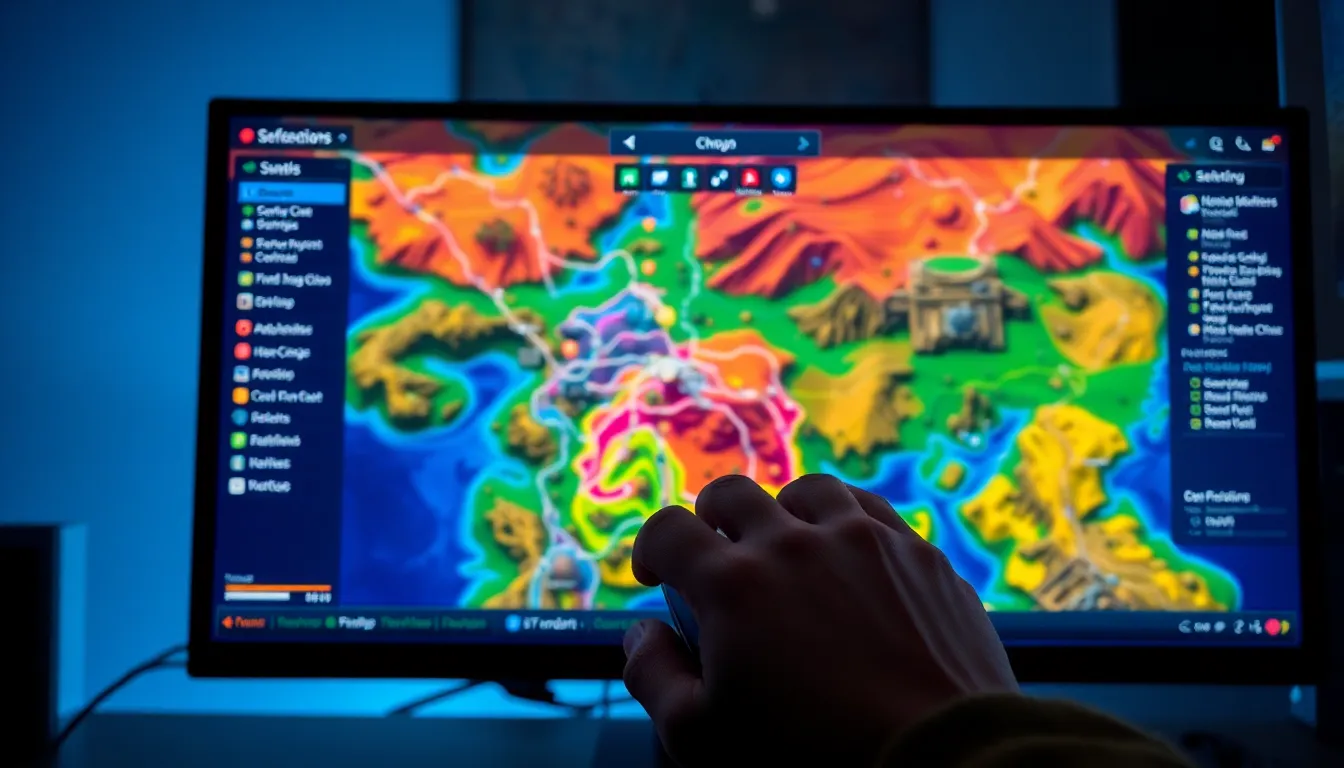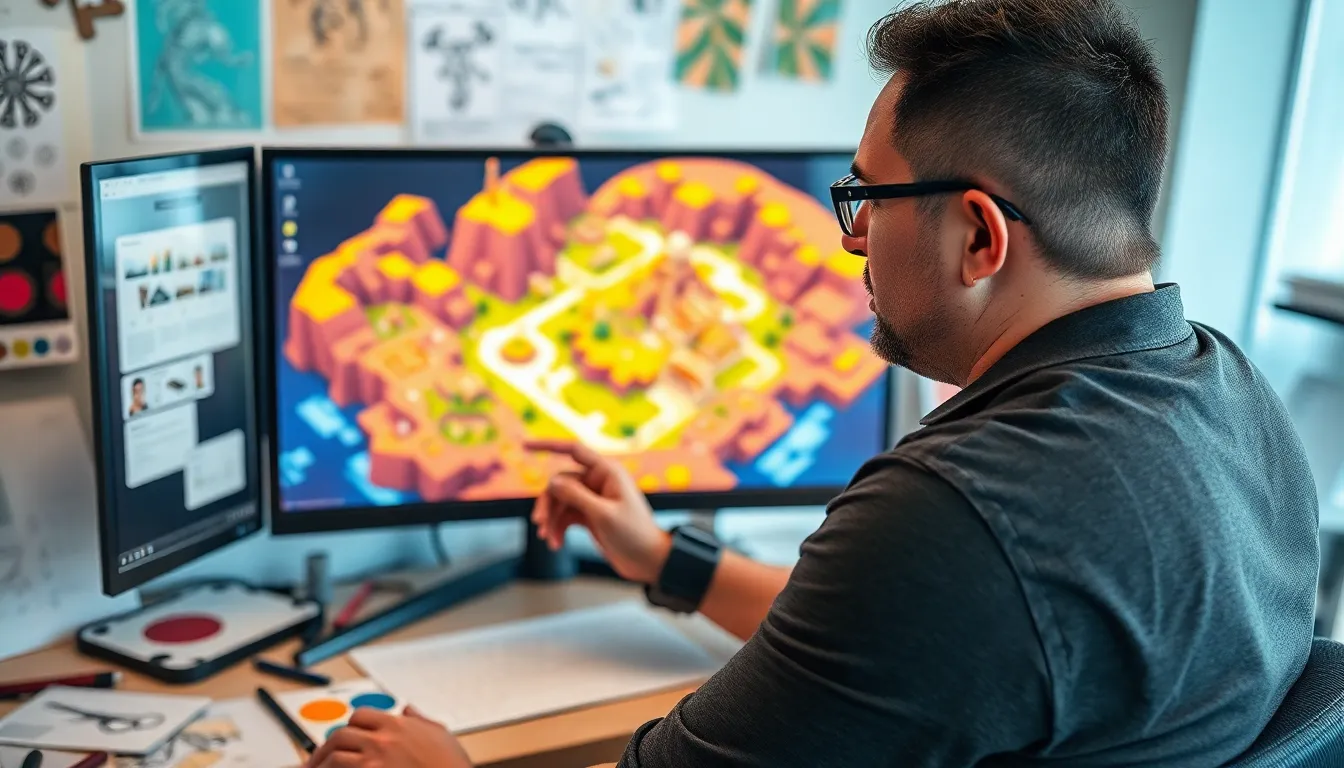Table of Contents
ToggleIn the vast world of gaming, mini maps can be the unsung heroes guiding players through treacherous terrains and epic quests. They’re like that friend who always knows the way to the best pizza joint—essential yet often taken for granted. A well-designed mini map can turn a player’s confusion into confidence, while a poorly crafted one can lead to a series of unfortunate events that even a cat with nine lives wouldn’t survive.
Overview of Mini Map Design
Mini maps play a critical role in enhancing gameplay experiences. Their primary function is to offer players a simplified visual representation of the game world. Efficiency in design influences how well players navigate complex environments.
Clarity in mini maps directs player attention to key locations, objectives, and points of interest. When a mini map accurately displays terrain and landmarks, players can easily orient themselves. Mapping details like obstacles and pathways also facilitates more strategic gameplay.
Color schemes impact usability significantly. Effective mini maps utilize contrasting colors to differentiate between various elements. For example, objectives may appear in bright colors while terrain is depicted in muted shades. This approach reduces cognitive load and enhances immediate comprehension.
Icons and legends ensure that players understand what they’re seeing. Adding symbols for specific actions or locations provides necessary context. Clear labeling and intuitive icons help players decipher mini map information quickly.
Scaling is another crucial aspect of mini map design. Proper zoom levels allow players to grasp both their immediate surroundings and larger game areas. Adjusting scales based on player proximity ensures relevant details are visible without overwhelming users.
User feedback informs continuous improvement in mini map design. Observations on player behavior and preferences guide adjustments to design elements. Developers must remain responsive to user experiences to create more effective navigation tools.
Ultimately, a well-crafted mini map contributes significantly to overall gameplay satisfaction. Designers must prioritize clarity, usability, and user engagement in their mini map designs. Effectively addressing these areas leads to more enjoyable and immersive gameplay experiences.
Importance of Mini Maps in Gaming

Mini maps serve as essential tools for players navigating intricate game environments. By offering a concise visual representation, mini maps significantly enhance gameplay dynamics.
Enhancing User Navigation
Effective mini maps simplify the navigation process. A well-structured design allows players to locate objectives quickly. Distinct colors and intuitive icons guide users through complex terrains. Players can orient themselves easily, reducing the learning curve associated with new maps. Clarity in mini map design ensures that critical information stands out. Users appreciate mini maps that adapt to their proximity to objectives, optimizing their route planning. Feedback from players aids developers in refining navigation features, making adjustments based on real-world usage.
Improving Gameplay Experience
Mini maps directly impact gameplay satisfaction. A thoughtfully designed mini map fosters a smoother experience for players, minimizing frustration. Clarity and user-friendly design elements contribute to a holistic and enjoyable gameplay environment. Enhanced visibility of key locations fuels strategic decision-making. Developers often prioritize effective iconography to ensure players understand their objectives instantly. Engaging mini maps keep players immersed in the gaming world, enhancing overall excitement. Continuous updates based on user feedback help maintain relevance and usability.
Key Elements of Effective Mini Map Design
Mini map design plays a pivotal role in enhancing gameplay by improving navigation. To achieve optimal usability, certain design elements must be prioritized.
Scale and Proportion
Scale significantly influences how players interpret their surroundings. Accurate scaling ensures that mini maps reflect the game world, allowing players to gauge distances effectively. When proportionate, players can easily relate their location to nearby landmarks and objectives. Adjusting scale based on player proximity enhances navigation further. A zoomed-in view may provide specific details when close to objectives, while a zoomed-out perspective offers a broader overview. Providing this flexibility increases player confidence in their explorations.
Color Schemes and Symbols
Effective color schemes contribute to the overall usability of a mini map. High-contrast colors help differentiate various elements, such as terrain, objectives, and player locations. Using intuitive symbols aids in quick recognition and comprehension. Clear icons for points of interest streamline the navigation process. Additionally, consistent symbolism throughout the game maintains familiarity, reducing cognitive load for players. Implementing distinct colors and symbols enhances clarity, making it easier for players to orient themselves within complex environments. Prioritizing these design choices can lead to a more satisfying gaming experience.
Common Mistakes in Mini Map Design
Mini map design often suffers from common errors that hinder usability. Recognizing these missteps is essential for creating effective navigation tools.
Overcomplicating the Design
Excessive detail can overwhelm players in a mini map. Complicated features and too many icons may distract from essential information. Clear pathways and landmarks should take precedence over clutter. Effective designs utilize simplicity to communicate vital navigation cues quickly. Players appreciate straightforward layouts that guide them with minimal confusion. Prioritizing clarity ensures users grasp their surroundings without feeling lost.
Neglecting User Feedback
Ignoring player feedback significantly detracts from mini map effectiveness. User insights provide valuable data on design flaws and usability issues. Continuous engagement with players helps refine features and improve overall experience. Developers benefit from understanding player needs and adjusting accordingly. Making iterative changes based on feedback elevates user satisfaction and enhances gameplay. Listening to the audience creates a mini map that resonates with their expectations and requirements.
Best Practices for Mini Map Design
Mini maps improve gameplay and navigation, so it’s vital to adopt best practices in their design. A user-centric design approach focuses on player needs and preferences, ensuring that maps remain intuitive. Developers should prioritize feedback from players to create maps that resonate with their expectations. Simplifying icons and maintaining clarity in symbols can enhance usability. Regularly evaluating how players interact with the mini map helps identify potential improvements.
Iterative testing and refinement play a key role in effective mini map design. Continuous testing reveals areas for improvement, allowing developers to address issues before a game’s release. Player sessions should guide refinements, ensuring maps adapt to user experiences. Feedback should be collected during beta releases and post-launch updates, which streamlines further adjustments. Employing analytics to track player interactions can pinpoint design weaknesses. Refining mini maps based on data contributes to an optimized gaming experience.
Mini map design plays a pivotal role in shaping the gaming experience. By prioritizing clarity and usability developers can create tools that truly enhance player navigation. Effective mini maps not only simplify complex environments but also empower players to make strategic decisions with ease.
Incorporating user feedback is essential for ongoing improvement and relevance. By engaging with players and refining designs based on their insights developers can ensure that mini maps remain intuitive and effective. Ultimately a well-crafted mini map is more than just a navigation tool; it’s an integral part of immersive gameplay that keeps players engaged and satisfied.







